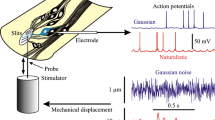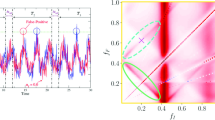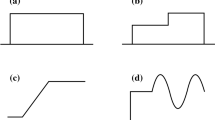Abstract
The encoding of mechanical stimuli into action potentials in two types of spider mechanoreceptor neurons is modeled by use of the principal dynamic modes (PDM) methodology. The PDM model is equivalent to the general Wiener–Bose model and consists of a minimum set of linear dynamic filters (PDMs), followed by a multivariate static nonlinearity and a threshold function. The PDMs are obtained by performing eigen-decomposition of a matrix constructed using the first-order and second-order Volterra kernels of the system, which are estimated by means of the Laguerre expansion technique, utilizing measurements of pseudorandom mechanical stimulation (input signal) and the resulting action potentials (output signal). The static nonlinearity, which can be viewed as a measure of the probability of action potential firing as a function of the PDM output values, is computed as the locus of points of the latter that correspond to output action potentials. The performance of the model is assessed by computing receiver operating characteristic (ROC) curves, akin to the ones used in decision theory and quantified by computing the area under the ROC curve. Three PDMs are revealed by the analysis. The first PDM exhibits a high-pass characteristic, illustrating the importance of the velocity of slit displacement in the generation of action potentials at the mechanoreceptor output, while the second and third PDMs exhibit band-pass and low-pass characteristics, respectively. The corresponding three-input nonlinearity exhibits asymmetric behavior with respect to its arguments, suggesting directional dependence of the mechanoreceptor response on the mechanical stimulation and the PDM outputs, in agreement to our findings from a previous study (Ann Biomed Eng 27:391–402, 1999). Differences between the Type A and B neurons are observed in the zeroth-order Volterra kernels (related to the average firing), as well as in the magnitudes of the second and third PDMs that perform band-pass and low-pass processing of the input signal, respectively.
Similar content being viewed by others
References
Bose AG (1956) A theory of nonlinear systems. Technical Report No. 309. Research Laboratory of Electronics, MIT, Cambridge
Del Prete Z, Baker SP, Grigg P (2003) Stretch responses of cutaneous RA afferent neurons in mouse hairy skin. J Neurophysiol 89:1649–1659
DiCaprio RA (2003) Nonspiking and spiking proprioceptors in the crab: nonlinear analysis of nonspiking TCMRO afferents. J Neurohysiol 89:1826–1836
Egan JP (1975) Signal detection theory and ROC analysis. Academic, New York
Eggermont JJ (1993) Wiener and Volterra analyses applied to the auditory system. Hear Res 66:177–201
Finkel AS, Redman S (1984) Theory and operation of single microelectrode voltage clamp. J Neurosci Meth 11:101–127
French AS (1992) Mechanotransduction. Annu Rev Physiol 54:135–152
French AS, Holden AV (1971) Alias-free sampling of neuronal spike trains. Kybernetik 8:165–171
French AS, Holden AV, Stein RB (1972) The estimation of the frequency response function of a mechanoreceptor. Kybernetik 11:15–23
French AS, Korenberg MJ (1989) A nonlinear cascade model for action potential encoding in an insect sensory neuron. Biophys J 55:655–661
French AS, Patrick SK (1994) A nonlinear model of step responses in the cockroach tactile spine neuron. Biol Cybern 70:435–441
French AS, Marmarelis VZ (1995) Nonlinear neuronal mode analysis of action potential encoding in the cockroach tactile spin neuron. Biol Cybern 73:425–430
French AS, Höger U, Sekizawa S-i, Torkkeli PH (2001) Frequency response functions and information capacities of paired mechanoreceptor neurons. Biol Cybern 85:293–300
Gamble ER, DiCaprio RA (2003) Nonspiking and spiking proprioceptors in the crab: white noise analysis of spiking CB-chordotonal organ afferents. J Neurophysiol 89:1815–1825
Juusola M, French AS (1995) Transduction and adaptation in spider slit sense organ mechanoreceptors. J Neurophysiol 74:2513–2523
Juusola M, Weckström M, Uusitalo RO, Korenberg MJ, French AS (1995) Nonlinear models of the first synapse in the light-adapted fly retine. J Neurophysiol 74:2538–2547
Juusola M, Seyfarth EA, French AS (1997) Rapid coating of glass-capillary microelectrodes for single-electrode voltage clamp. J Neurosci Meth 71:199–204
Koles ZJ, Smith RS (1974) Characteristics of the sensory discharge of the muscle spindle in Xenopus laevix. Kybernetik 15:99–110
Kondoh Y, Okuma J, Newland PL (1995) Dynamics of neurons controlling movements of a locust hind leg: Wiener kernel analysis of the responses of proprioceptive afferents. J Neurophysiol 73:1829–1842
Looft PJ, Baltensperger CM (1990) Linear systems analysis of cutaneous type I mechanoreceptors. IEEE Trans Biomed Eng 37:565–573
Marmarelis VZ (1989) Signal transformation and coding in neural systems. IEEE Trans Biomed Engin 36:15–24
Marmarelis VZ (1993) Identification of nonlinear biological systems using Laguerre expansion of kernels. Ann Biomed Eng 21:573–589
Marmarelis VZ (1997) Modeling methodology for nonlinear physiological systems. Ann Biomed Eng 25:239–251
Marmarelis VZ (2004) Nonlinear dynamic modeling of physiological systems. IEEE Press & Wiley-Interscience, Hoboken, New Jersey
Marmarelis VZ, Juusola M, French AS (1999) Principal dynamic mode analysis of nonlinear transduction in a spider mechanoreceptor. Ann Biomed Eng 27:391–402
Marmarelis VZ, Orme ME (1993) Modeling of neural systems by use of neuronal modes. IEEE Trans Biomed Engin 40: 1149–1158
Matthews PC, Stein, RB (1969) The sensitivity of muscle spindle afferents to small sinusoidal changes in length. J Physiol (Lond) 200:723–743
McFall RM, Treat TA (1999) Quantifying the information value of clinical assessments with signal detection theory. Annu Rev Psychol 1999:50215–50241
Sakai HM (1992) White-noise analysis in neurophysiology. Phys Rev 72:491–505
Sekizawa S-i, French AS, Höger U, Torkkeli PH (1999) Voltage-activated potassium outward currents in two types of spider mechanoreceptor neurons. J Neurophysiol 81:2937–2944
Seyfarth EA, French AS (1994) Intracellular characterization of identified sensory cells in a new spider mechanoreceptor preparation. J Neurophysiol 71:1422–1427
Swets JA, Pickett RM (1992) Evaluation of diagnostic systems: Methods from signal detection theory. Academic, New York
Torkkeli PH, Sekizawa S-i, French AS (2001) Inactivation of voltage-activated Na+ currents contributes to different adaptation properties of paired mechanosensory neurons. J Neurophysiol 85:1595–1602
Torkkeli PH, French AS (2002) Simulation of different firing patterns in paired spider mechanoreceptor neurons: The role of Na+ channel inactivation. J Neurophysiol 87:1363–1368
Webber RM, Stanley GB (2004) Nonlinear encoding of tactile patterns in the barrel cortex. J Neurophysiol 91:2010–2022
Author information
Authors and Affiliations
Corresponding author
Rights and permissions
About this article
Cite this article
Mitsis, G.D., French, A.S., Höger, U. et al. Principal dynamic mode analysis of action potential firing in a spider mechanoreceptor. Biol Cybern 96, 113–127 (2007). https://doi.org/10.1007/s00422-006-0108-2
Received:
Accepted:
Published:
Issue Date:
DOI: https://doi.org/10.1007/s00422-006-0108-2




